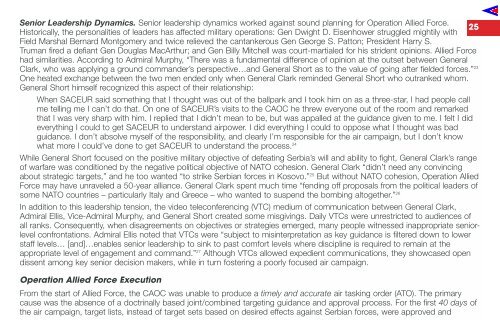Volume 4 No 1 - Air Power Studies
Volume 4 No 1 - Air Power Studies
Volume 4 No 1 - Air Power Studies
You also want an ePaper? Increase the reach of your titles
YUMPU automatically turns print PDFs into web optimized ePapers that Google loves.
Senior Leadership Dynamics. Senior leadership dynamics worked against sound planning for Operation Allied Force.<br />
25<br />
Historically, the personalities of leaders has affected military operations: Gen Dwight D. Eisenhower struggled mightily with<br />
Field Marshal Bernard Montgomery and twice relieved the cantankerous Gen George S. Patton; President Harry S.<br />
Truman fired a defiant Gen Douglas MacArthur; and Gen Billy Mitchell was court-martialed for his strident opinions. Allied Force<br />
had similarities. According to Admiral Murphy, “There was a fundamental difference of opinion at the outset between General<br />
Clark, who was applying a ground commander’s perspective…and General Short as to the value of going after fielded forces.” 23<br />
One heated exchange between the two men ended only when General Clark reminded General Short who outranked whom.<br />
General Short himself recognized this aspect of their relationship:<br />
When SACEUR said something that I thought was out of the ballpark and I took him on as a three-star, I had people call<br />
me telling me I can’t do that. On one of SACEUR’s visits to the CAOC he threw everyone out of the room and remarked<br />
that I was very sharp with him. I replied that I didn’t mean to be, but was appalled at the guidance given to me. I felt I did<br />
everything I could to get SACEUR to understand airpower. I did everything I could to oppose what I thought was bad<br />
guidance. I don’t absolve myself of the responsibility, and clearly I’m responsible for the air campaign, but I don’t know<br />
what more I could’ve done to get SACEUR to understand the process. 24<br />
While General Short focused on the positive military objective of defeating Serbia’s will and ability to fight, General Clark’s range<br />
of warfare was conditioned by the negative political objective of NATO cohesion. General Clark “didn’t need any convincing<br />
about strategic targets,” and he too wanted “to strike Serbian forces in Kosovo.” 25 But without NATO cohesion, Operation Allied<br />
Force may have unraveled a 50-year alliance. General Clark spent much time “fending off proposals from the political leaders of<br />
some NATO countries – particularly Italy and Greece – who wanted to suspend the bombing altogether.” 26<br />
In addition to this leadership tension, the video teleconferencing (VTC) medium of communication between General Clark,<br />
Admiral Ellis, Vice-Admiral Murphy, and General Short created some misgivings. Daily VTCs were unrestricted to audiences of<br />
all ranks. Consequently, when disagreements on objectives or strategies emerged, many people witnessed inappropriate seniorlevel<br />
confrontations. Admiral Ellis noted that VTCs were “subject to misinterpretation as key guidance is filtered down to lower<br />
staff levels… [and]…enables senior leadership to sink to past comfort levels where discipline is required to remain at the<br />
appropriate level of engagement and command.” 27 Although VTCs allowed expedient communications, they showcased open<br />
dissent among key senior decision makers, while in turn fostering a poorly focused air campaign.<br />
Operation Allied Force Execution<br />
From the start of Allied Force, the CAOC was unable to produce a timely and accurate air tasking order (ATO). The primary<br />
cause was the absence of a doctrinally based joint/combined targeting guidance and approval process. For the first 40 days of<br />
the air campaign, target lists, instead of target sets based on desired effects against Serbian forces, were approved and
















